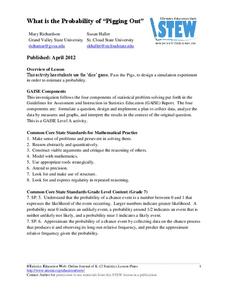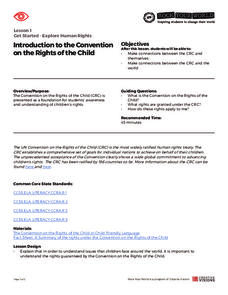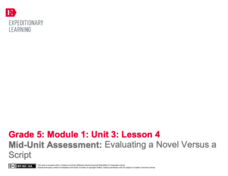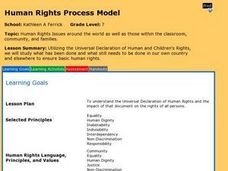EngageNY
Drafting Individual Readers Theater Scripts for a Specific Scene: Narrowing Text for our Readers Theater Scripts
Let's focus. In small groups, writers narrow text selections to produce a narrative script based on the novel Esperanza Rising by Pam Muñoz Ryan. Next, pupils plan their reader's theater scripts based on the text.
Curated OER
Human Rights Education Handbook: Perpetrator, Victim, Bystander, Healer
Students describe a time when they played different roles regarding human rights. They are divided into small groups and assigned roles of "Perpetrator," "Victim," "Bystander," and "Healer." Individual students give an example of a time...
Curated OER
Human Rights Education Handbook: Image Theater
Students create a human machine to represent a concept related to human rights such as opression, liberation, justice. They make one machine per group, adding one person with a repeating sound and motion at a time.
Curated OER
Regents High School Examination PHYSICAL SETTING CHEMISTRY 2007
The University of the State of New York has designed a series of exams to be given to high schoolers. This chemistry exam is one of the most comprehensive and well-written that you will ever find. It consists of 84 questions in a variety...
Curated OER
I Know Why the Caged Bird Sings: Human Rights
Students define the universal rights of human beings. In this human rights lesson, students visit the website about the Universal Declaration of Human Rights and read all parts of the document. Students discuss why there is a need for...
Curated OER
Roads to Refuge: Refugees in Australia
Young scholars identify terms asylum seeker, refugee and migrant, and discuss differences. Students examine significance of persecution in refugee context, explore concept of human rights and discuss some key articles from Universal...
Curated OER
I Know Why the Caged Bird Sings: Human Rights
Students use Maya Angelou's I Know Why the Caged Bird Sings as analysis on human rights. In this human rights lesson, students develop an awareness of human rights issues and explore the Universal Declaration of Human Rights using the...
Curated OER
I Know Why the Caged Bird Sings: Human Rights in the News
Students examine human rights issues using Maya Angelou's I Know Why the Caged Bird Sings. In this human rights activity, students review a copy of the Universal Declaration of Human Rights and complete a survey for their school about...
Curated OER
I Know Why the Caged Bird Sings: Giving Human Rights a Face
Students produce a creative expression of an article of the Universal Declaration of Human Rights. In this human rights lesson, students use the website for the UDHR to complete activities about human rights.
Curated OER
Orange Revolution
Tenth graders explore the concept of Human Rights. In this World History lesson, 10th graders examine the Declaration of Human Rights. Students compare human rights issues in Ukraine and other countries.
American Statistical Association
What is the Probability of “Pigging Out”
Learners apply their understanding of luck to a probability experiment. They play a game of Pass the Pigs to determine the probability of a specific outcome. Using analysis for their data, pupils declare the measures of center, dot...
Curated OER
Private Property Vs. the Public Good: the Problem of Eminent Domain
Students view video The Electric Valley, discuss film clips and review news articles and other documents pertaining to eminent domain, prepare declarative statement on issue that has pro or con side, and present case to opposing side in...
Creative Visions Foundation
Visual Interpretations of the CRC
How can people better understand the human rights that are guaranteed to children around the world? Pupils attempt to answer the question with the second of two lessons explaining the Introduction to the Convention on the Rights of the...
Creative Visions Foundation
Introduction to the Convention on the Rights of the Child
The UN Conventions on the Rights of the Child (CRC) has been ratified by 196 countries so far ... and still counting! Using the first of two lessons covering the Introduction to the Convention on the Rights of the Child, scholars learn...
EngageNY
Mid-Unit Assessment: Evaluating a Novel Versus a Script
How are novels and scripts alike and different? As part of the mid-unit assessment, scholars complete a Venn diagram to compare two types of writing: a novel and a script. Next, they respond to short-answer questions, evaluating passages...
Curated OER
United Nations International Declaration of Human Rights (1947) - 12 October 2000
Students use the 1947 Declaration of Human Rights to explore the concept of basic human rights in relation to past and present world situations. They brainstorm or think of cases where rights are being abused at school, in Australia or...
Curated OER
Refugees and Children in Our World
Students study the human rights of refugee populations around the world. In this human rights lesson, students research the problems of refugees around the world. They investigate the basic human need for dignity and read about the...
Curated OER
Who’s Got Rights? An Introduction to Human Rights and Human Rights Defenders
Young scholars explore human rights issues. For this social justice lesson, students examine human rights as they read segments of the "Universal Declaration of Human Rights," discuss photographs with human rights implications, and play...
Curated OER
Introducing the 1981 United Nations Declaration on Freedom of Religion or Belief
Students examine the United Nations Declaraction on Freedom of Religion and Beliefs. As a class, they distinguish between the definitions of worship, observance, practice and teaching. In groups, they evaluate the definitions of...
Curated OER
History: Declaration of Conscience Political Cartoons
Students examine political cartoons depicting opinions about Margaret Chase Smith's Declaration of conscience. After examining the cartoons, they create their own political cartoons about the speech. As an ongoing activity, students...
Curated OER
Exploring the 1981 United Nations Declaration on the Elimination of All Forms of Intolerance and of Discrimination Based on Religion or Belief
Students are introduced to the United Nations Declaraion on the Elimination of All Forms of Intolerence and of Discrimination Based on Religion or Belief. Using the document, they discuss issues raised about the source of rights linked...
Curated OER
Obstacles to Perseverance
What does it mean to persevere. Young historians review the definition of perseverance then brainstorm a list of obstacles colonists and revolutionaries had to overcome during the American Revolution. Using this list, they identify...
Curated OER
Regents High School Examination: Geometry (June 2009)
The University of New York Regents High School Exam for geometry from June 2009 is comprehensive in scope with 38 questions over 22 pages. A reference sheet with relevant formulas is included.
Curated OER
Human Rights Issues Around the World
Seventh graders begin the lesson by comparing and contrasting the Bill of Rights with the Universal Declaration of Human Rights. For each document, they highlight the material that is the same for both and discuss the items that are...

























